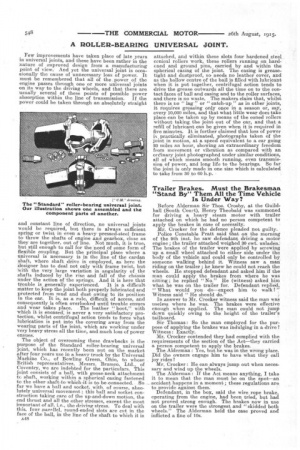A ROLLER-BEARING UNIVERSAL JOINT.
Page 18

If you've noticed an error in this article please click here to report it so we can fix it.
Few improvements have taken place of late years in universal joints, and these have been rather in the nature of .improved design from a manufacturing point of view. And yet the universal joint is occasionally the cause of unnecessary loss of power. It must be remembered that all of the power of the engine passes through one or more universal joints on its way to the driving wheels, and that there are usually several of these points of possible power absorption within the line of transmission. If the power could be taken through an absolutely straight and constant line of direction, no universal joints -would be required, but there is always sufficient spring or twist in even a heavy pressed-steel frame to throw the shafts of engine and gearbox, close as they are together, out of line. Not much, it is true, but still enough to call for the need of some form of flexible coupling. But the principal place where a universal is necessary is in the line of the cardan shaft, where shaft drive is employed, as here the designer has to deal not only with frame twist, but with the very large variation in angularity of the shafts induced by the rise and fall of the chassis under the action of the springs. And it is here that trouble is generally experienced. It is a difficult matter to keep the joint both properly lubricated and protected from mud and dust owing to its position in the car. It is, as a, rule, difficult of access, and consequently is often overlooked until trouble ensues and wear takes place. The leather "boot," with which it is encased, is never a very satisfactory protection, whilst centrifugal action tends to force what lubrication is put into the covering away from the wearing parts of the joint, which are working under very heavy stress all the time, and much loss of power ensues.
The object of overcoming these drawbacks is the purpose of the Standard roller-bearing universal joint, which has recently been put on the market after four years use in a heavy truck by the Universal Machine Co., of Bowling Green, Ohio, to whose British representatives, Messrs. Bramco, Ltd., of Coventry, we are indebted for the particulars. This joint consists of a ball, with goose-neck attachment te shaft, working within a spherical casing fastened to the other shaft-to which it. is to be-connected. So far we have a ball and socket, with, of course, absolutely universal movement ; this ball and socket construction taking care of the up-and-down motion, the end thrust and all the other stresses, except the most important of all. i.e., the driving stress. To deal with this, four .parellel, round-ended slots are cut in the face of the ball, in the line of the shaft to which it is A48
attached, and within these slots four hardened steel cenical rollers work, these rollers running on hardened and ground pins, carried by and within the spherical casing of the joint. The casing is greasetight and dustproof, so needs no leather cover, and as the hollow centre of the ball is filled with lubricant when it is put together, centrifugal action tends to drive the grease outwards all the time on to the contact faces of ball and casing and to the roller surfaces, and there is no waste. The makers claim that, whilst there is no " lag" or " catch-up " as in other joints, it requires greasing only once in a season or, say, every 10,000 miles, and that what little wear does take place can be taken up by means of the coned rollers withouttaking the joint out of the car, and that .a refill of lubricant can be given when it is required in five minutes. It is further claimed that loss of power iii. practically eliminated, photographs taken of the joint in motion, at a speed equivalent to a car going 20 miles an hour, showing an extraordinary freedom from movement or vibration as compared with an ordinary joint photographed under similar conditions, all of which means smooth running, even transmission of power, and long life to the bearings. So far the joint is only made in one size which is calculated to take from 30 to 60 h.p.






















